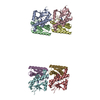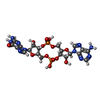+ Open data
Open data
- Basic information
Basic information
| Entry | Database: PDB / ID: 7una | ||||||||||||||||||||||||||||||||||||
|---|---|---|---|---|---|---|---|---|---|---|---|---|---|---|---|---|---|---|---|---|---|---|---|---|---|---|---|---|---|---|---|---|---|---|---|---|---|
| Title | SfSTING with cGAMP (masked) | ||||||||||||||||||||||||||||||||||||
 Components Components | CD-NTase-associated protein 12 | ||||||||||||||||||||||||||||||||||||
 Keywords Keywords | ANTIVIRAL PROTEIN / STING / bacterial / filament | ||||||||||||||||||||||||||||||||||||
| Function / homology |  Function and homology information Function and homology informationNAD+ glycohydrolase / NADP+ nucleosidase activity / NAD+ nucleosidase activity / defense response to virus / nucleotide binding Similarity search - Function | ||||||||||||||||||||||||||||||||||||
| Biological species |  Sphingobacterium faecium (bacteria) Sphingobacterium faecium (bacteria) | ||||||||||||||||||||||||||||||||||||
| Method | ELECTRON MICROSCOPY / single particle reconstruction / cryo EM / Resolution: 4 Å | ||||||||||||||||||||||||||||||||||||
 Authors Authors | Morehouse, B.R. / Yip, M.C.J. / Keszei, A.F.A. / McNamara-Bordewick, N.K. / Shao, S. / Kranzusch, P.J. | ||||||||||||||||||||||||||||||||||||
| Funding support |  United States, 11items United States, 11items
| ||||||||||||||||||||||||||||||||||||
 Citation Citation |  Journal: Nature / Year: 2022 Journal: Nature / Year: 2022Title: Cryo-EM structure of an active bacterial TIR-STING filament complex. Authors: Benjamin R Morehouse / Matthew C J Yip / Alexander F A Keszei / Nora K McNamara-Bordewick / Sichen Shao / Philip J Kranzusch /  Abstract: Stimulator of interferon genes (STING) is an antiviral signalling protein that is broadly conserved in both innate immunity in animals and phage defence in prokaryotes. Activation of STING requires ...Stimulator of interferon genes (STING) is an antiviral signalling protein that is broadly conserved in both innate immunity in animals and phage defence in prokaryotes. Activation of STING requires its assembly into an oligomeric filament structure through binding of a cyclic dinucleotide, but the molecular basis of STING filament assembly and extension remains unknown. Here we use cryogenic electron microscopy to determine the structure of the active Toll/interleukin-1 receptor (TIR)-STING filament complex from a Sphingobacterium faecium cyclic-oligonucleotide-based antiphage signalling system (CBASS) defence operon. Bacterial TIR-STING filament formation is driven by STING interfaces that become exposed on high-affinity recognition of the cognate cyclic dinucleotide signal c-di-GMP. Repeating dimeric STING units stack laterally head-to-head through surface interfaces, which are also essential for human STING tetramer formation and downstream immune signalling in mammals. The active bacterial TIR-STING structure reveals further cross-filament contacts that brace the assembly and coordinate packing of the associated TIR NADase effector domains at the base of the filament to drive NAD hydrolysis. STING interface and cross-filament contacts are essential for cell growth arrest in vivo and reveal a stepwise mechanism of activation whereby STING filament assembly is required for subsequent effector activation. Our results define the structural basis of STING filament formation in prokaryotic antiviral signalling. | ||||||||||||||||||||||||||||||||||||
| History |
|
- Structure visualization
Structure visualization
| Structure viewer | Molecule:  Molmil Molmil Jmol/JSmol Jmol/JSmol |
|---|
- Downloads & links
Downloads & links
- Download
Download
| PDBx/mmCIF format |  7una.cif.gz 7una.cif.gz | 404 KB | Display |  PDBx/mmCIF format PDBx/mmCIF format |
|---|---|---|---|---|
| PDB format |  pdb7una.ent.gz pdb7una.ent.gz | 327.7 KB | Display |  PDB format PDB format |
| PDBx/mmJSON format |  7una.json.gz 7una.json.gz | Tree view |  PDBx/mmJSON format PDBx/mmJSON format | |
| Others |  Other downloads Other downloads |
-Validation report
| Summary document |  7una_validation.pdf.gz 7una_validation.pdf.gz | 1.4 MB | Display |  wwPDB validaton report wwPDB validaton report |
|---|---|---|---|---|
| Full document |  7una_full_validation.pdf.gz 7una_full_validation.pdf.gz | 1.4 MB | Display | |
| Data in XML |  7una_validation.xml.gz 7una_validation.xml.gz | 51.7 KB | Display | |
| Data in CIF |  7una_validation.cif.gz 7una_validation.cif.gz | 72.1 KB | Display | |
| Arichive directory |  https://data.pdbj.org/pub/pdb/validation_reports/un/7una https://data.pdbj.org/pub/pdb/validation_reports/un/7una ftp://data.pdbj.org/pub/pdb/validation_reports/un/7una ftp://data.pdbj.org/pub/pdb/validation_reports/un/7una | HTTPS FTP |
-Related structure data
| Related structure data |  26618MC  7un8C  7un9C C: citing same article ( M: map data used to model this data |
|---|---|
| Similar structure data | Similarity search - Function & homology  F&H Search F&H Search |
- Links
Links
- Assembly
Assembly
| Deposited unit | 
|
|---|---|
| 1 |
|
- Components
Components
| #1: Protein | Mass: 36956.051 Da / Num. of mol.: 8 Source method: isolated from a genetically manipulated source Source: (gene. exp.)  Sphingobacterium faecium (bacteria) / Gene: cap12, C8N37_104320, SF1_08920 / Production host: Sphingobacterium faecium (bacteria) / Gene: cap12, C8N37_104320, SF1_08920 / Production host:  #2: Chemical | ChemComp-4BW / Has ligand of interest | Y | |
|---|
-Experimental details
-Experiment
| Experiment | Method: ELECTRON MICROSCOPY |
|---|---|
| EM experiment | Aggregation state: FILAMENT / 3D reconstruction method: single particle reconstruction |
- Sample preparation
Sample preparation
| Component | Name: SfSTING with cGAMP / Type: COMPLEX / Entity ID: #1 / Source: RECOMBINANT |
|---|---|
| Molecular weight | Experimental value: NO |
| Source (natural) | Organism:  Sphingobacterium faecium (bacteria) Sphingobacterium faecium (bacteria) |
| Source (recombinant) | Organism:  |
| Buffer solution | pH: 7.5 |
| Specimen | Embedding applied: NO / Shadowing applied: NO / Staining applied: NO / Vitrification applied: YES |
| Vitrification | Cryogen name: ETHANE |
- Electron microscopy imaging
Electron microscopy imaging
| Experimental equipment |  Model: Talos Arctica / Image courtesy: FEI Company |
|---|---|
| Microscopy | Model: FEI TALOS ARCTICA |
| Electron gun | Electron source:  FIELD EMISSION GUN / Accelerating voltage: 200 kV / Illumination mode: FLOOD BEAM FIELD EMISSION GUN / Accelerating voltage: 200 kV / Illumination mode: FLOOD BEAM |
| Electron lens | Mode: BRIGHT FIELD / Nominal defocus max: 2600 nm / Nominal defocus min: 1400 nm |
| Image recording | Electron dose: 52.9 e/Å2 / Film or detector model: GATAN K3 (6k x 4k) |
- Processing
Processing
| CTF correction | Type: PHASE FLIPPING AND AMPLITUDE CORRECTION |
|---|---|
| 3D reconstruction | Resolution: 4 Å / Resolution method: FSC 0.143 CUT-OFF / Num. of particles: 105567 / Symmetry type: POINT |
 Movie
Movie Controller
Controller






 PDBj
PDBj

